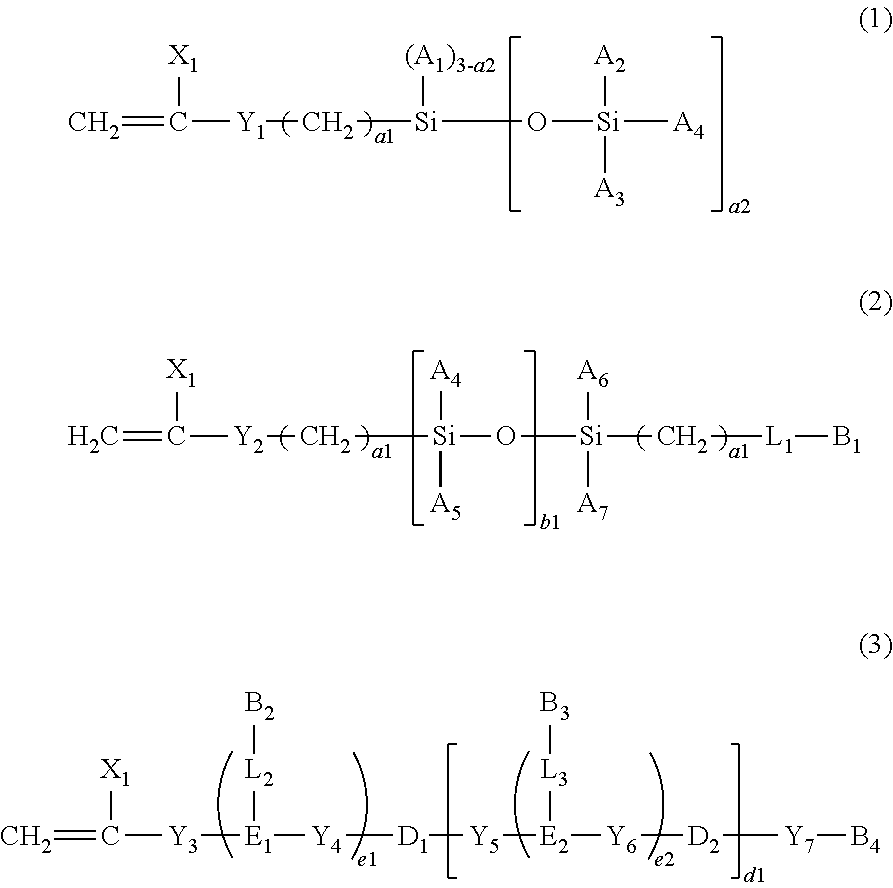Water-processable silicone-containing prepolymers and uses thereof
a technology of silicone hydrogel and silicone hydrogel, which is applied in the field of soft silicone hydrogel contact lenses, can solve the problems of corneal swelling, inability to easily circumvent oxygen, and undesirable growth of blood vessels in the cornea
- Summary
- Abstract
- Description
- Claims
- Application Information
AI Technical Summary
Benefits of technology
Problems solved by technology
Method used
Image
Examples
example 1
Oxygen Permeability Measurements
[0199]The apparent oxygen permeability of a lens and oxygen transmissibility of a lens material is determined according to a technique similar to the one described in U.S. Pat. No. 5,760,100 and in an article by Winterton et al., (The Cornea: Transactions of the World Congress on the Cornea 111, H. D. Cavanagh Ed., Raven Press: New York 1988, pp 273-280), both of which are herein incorporated by reference in their entireties. Oxygen fluxes (J) are measured at 34° C. in a wet cell (i.e., gas streams are maintained at about 100% relative humidity) using a Dk1000 instrument (available from Applied Design and Development Co., Norcross, Ga.), or similar analytical instrument. An air stream, having a known percentage of oxygen (e.g., 21%), is passed across one side of the lens at a rate of about 10 to 20 cm3 / min., while a nitrogen stream is passed on the opposite side of the lens at a rate of about 10 to 20 cm3 / min. A sample is equilibrated in a test media ...
example 2
[0218]A one-liter reaction vessel is evacuated overnight to remove moisture, and the vacuum broken with dry nitrogen. 73.59 g (75 meq) of dried X-22-160AS (α,ω-bis(2-hydroxyethoxypropyl)-polydimethylsiloxane, M.W.˜1000, from Shin-Etsu) is charged to the reactor and then about 16.67 g (75 meq) of freshly distilled isophorone diisocyanate (IPDI) is added into the reactor. The reactor is purged with nitrogen and heated to 45° C. with stirring and about 0.30 g of dibutyltin dilaurate (DBTDL) is added. The reactor is sealed, and a positive flow of nitrogen is maintained. An exotherm occurs, after which the reaction mixture is allowed to cool and stir at 55° C. for 2 hours. About 56.25 g (75 meq) of dried mono-methoxy-terminated polyethylene glycol, M.W.˜750) is added to the reactor at 55° C., followed by 100 μL of DBTDL. The reaction is continued for 8 hours before heating is discontinued and the reactor is allowed to cool overnight. The nitrogen bubble is discontinued and the reactor is...
example 3
[0219]A one-liter reaction vessel is evacuated overnight to remove moisture, and the vacuum broken with dry nitrogen. 73.59 g (75 meq) of dried X-22-160AS (α,ω-bis(2-hydroxyethoxypropyl)-polydimethylsiloxane, M.W.˜1000, from Shin-Etsu) is charged to the reactor and then about 39.23 g (176.5 meq) of freshly distilled isophorone diisocyanate (IPDI) is added into the reactor. The reactor is purged with nitrogen and heated to 45° C. with stirring and then about 0.30 g of dibutyltin dilaurate (DBTDL) is added. The reactor is sealed, and a positive flow of nitrogen is maintained. An exotherm occurs, after which the reaction mixture is allowed to cool and stir at 55° C. for 2 hours. About 72.12 g (66.20 meq) of dried Ymer™ N120 (mono-3,3-bis(hydroxymethyl)butyl- and mono-methoxy-terminated polyethylene glycol, M.W.˜1000, from Perstorp Polyols, Inc.) is added to the reactor at 55° C., followed by 100 μL of DBTDL. The reaction is continued for 8 hours before heating is discontinued and the r...
PUM
| Property | Measurement | Unit |
|---|---|---|
| molecular weight | aaaaa | aaaaa |
| water contact angle | aaaaa | aaaaa |
| elastic modulus | aaaaa | aaaaa |
Abstract
Description
Claims
Application Information
 Login to View More
Login to View More - R&D
- Intellectual Property
- Life Sciences
- Materials
- Tech Scout
- Unparalleled Data Quality
- Higher Quality Content
- 60% Fewer Hallucinations
Browse by: Latest US Patents, China's latest patents, Technical Efficacy Thesaurus, Application Domain, Technology Topic, Popular Technical Reports.
© 2025 PatSnap. All rights reserved.Legal|Privacy policy|Modern Slavery Act Transparency Statement|Sitemap|About US| Contact US: help@patsnap.com



